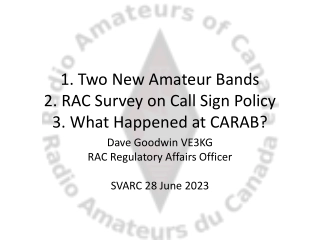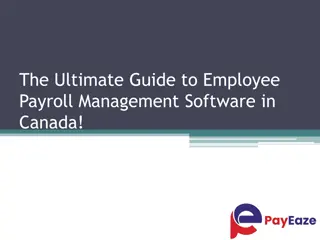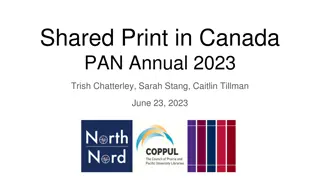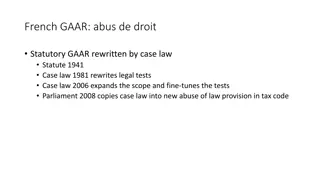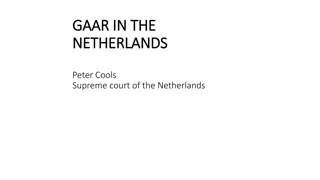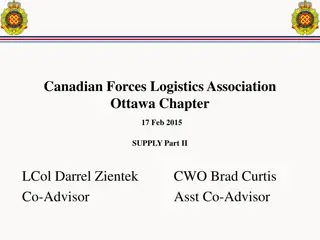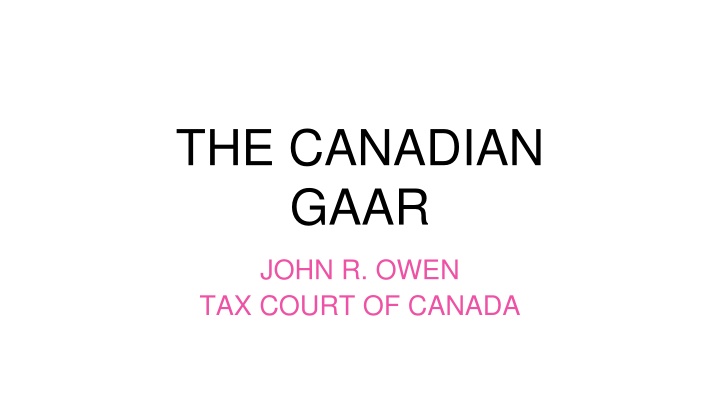
The Canadian GAAR Tax Regulations
Learn about the General Anti-Avoidance Rule (GAAR) in Canada, its history, application, and three-prong test to determine misuse or abuse of tax laws. Explore the implications, burden of proof on taxpayers, and judicial interpretations.
Download Presentation

Please find below an Image/Link to download the presentation.
The content on the website is provided AS IS for your information and personal use only. It may not be sold, licensed, or shared on other websites without obtaining consent from the author. If you encounter any issues during the download, it is possible that the publisher has removed the file from their server.
You are allowed to download the files provided on this website for personal or commercial use, subject to the condition that they are used lawfully. All files are the property of their respective owners.
The content on the website is provided AS IS for your information and personal use only. It may not be sold, licensed, or shared on other websites without obtaining consent from the author.
E N D
Presentation Transcript
THE CANADIAN GAAR JOHN R. OWEN TAX COURT OF CANADA
Enacted in September 1988 and amended in 2004 with retroactive effect to the date of enactment 2004 amendment explicitly extended application of GAAR to Tax Treaties Three Supreme Court of Canada Judgments interpret the GAAR: Canada Trustco (2005) Lipson (2009) Copthorne (2011) THE CANADIAN GAAR
The GAAR applies a three prong test: Is there a tax benefit? Is there an avoidance transaction? Is it reasonable to consider that the avoidance transaction results directly or indirectly in a misuse or an abuse of a provision of the Income Tax Act the Income Tax Regulations the Income Tax Application Rules, or any other enactment relevant in computing tax or any other amount payable or refundable under the Income Tax Act THE CANADIAN GAAR
A tax benefit exists if there is reduction, avoidance or deferral of tax or an increase in a refund of tax The quantum of the tax benefit is not relevant An avoidance transaction exists if the transaction, or a series of transactions transaction, results indirectly in a tax benefit, and it may reasonably be considered that the transaction undertaken or arranged primarily for bona fide purposes other than to obtain the tax benefit a THE that includes directly the or CANADIAN GAAR was not The definition of avoidance transaction requires an objective assessment of the relative importance forces of the transaction of the driving
Whether avoidance transaction exists is a question of fact for the judge to determine The Minister of National Revenue may assume facts that establish the existence of a tax benefit and an avoidance transaction The burden is on the taxpayer to prove facts that conclusion that there is no tax benefit and/or transaction a tax benefit or an THE CANADIAN GAAR support the no avoidance
The Supreme Court has condensed the statutory misuse or abuse test into a single question: Is the impugned transaction abusive? The question avoidance transaction is abusive is a mixed question of fact and law An avoidance transaction is abusive if the transaction viewed in context frustrates the purpose of the provision(s) giving rise to the tax benefit avoidance THE of whether an CANADIAN GAAR object, spirit or
The Minister of National Revenue must identify the object, spirit or purpose rationale) of the statutory provision(s) and must clearly establish abuse To assess the Minister s position, the court must first employ a unified textual, contextual and purposive (TCP) interpretation of the statutory provision(s) to determine object, spirit or purpose The search is for the rationale that underlies the words that may not be captured by the bare meaning of the words themselves The heart of the analysis is a contextual and purposive interpretation of the provisions The court must then determine whether the avoidance transaction falls within or frustrates the identified object, spirit or purpose (ie, legislative THE CANADIAN GAAR
The objective, thorough and step-by- step analysis of the provision(s) and explain the conclusion regarding whether or not the avoidance transaction is abusive The abusive nature of the avoidance transaction must be clear and the benefit of the doubt is given to the taxpayer court must conduct an reasons for its THE CANADIAN GAAR






